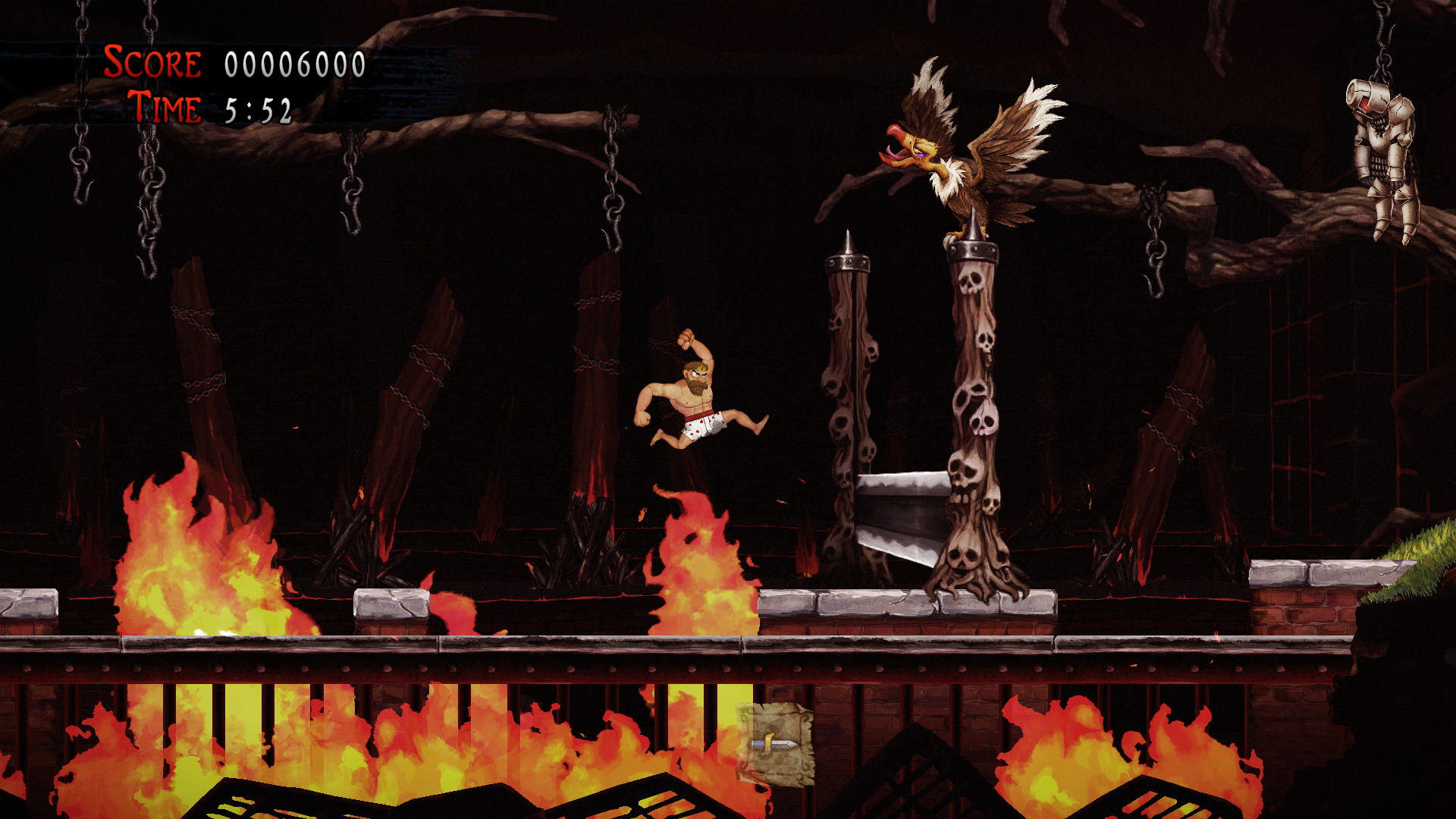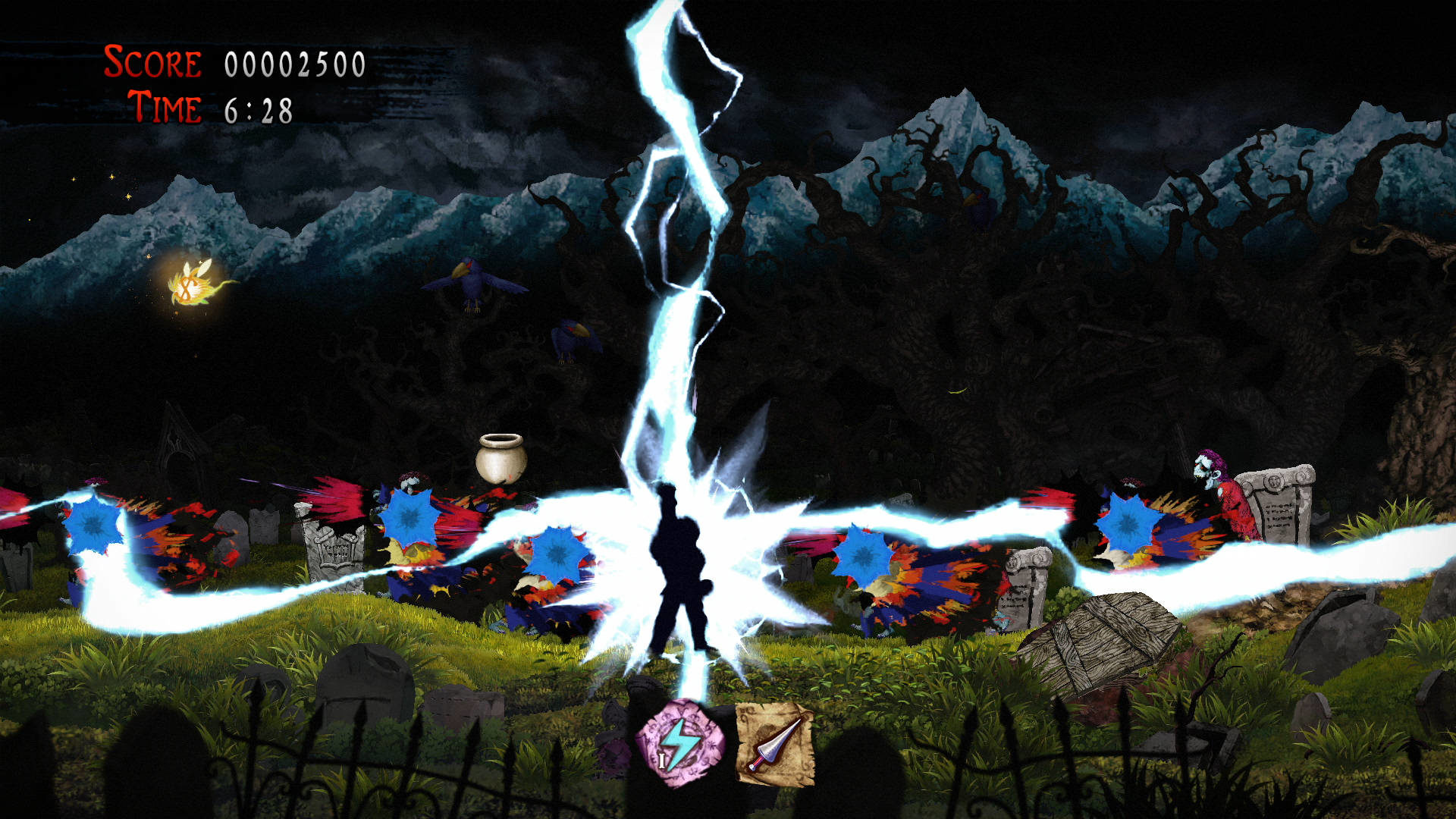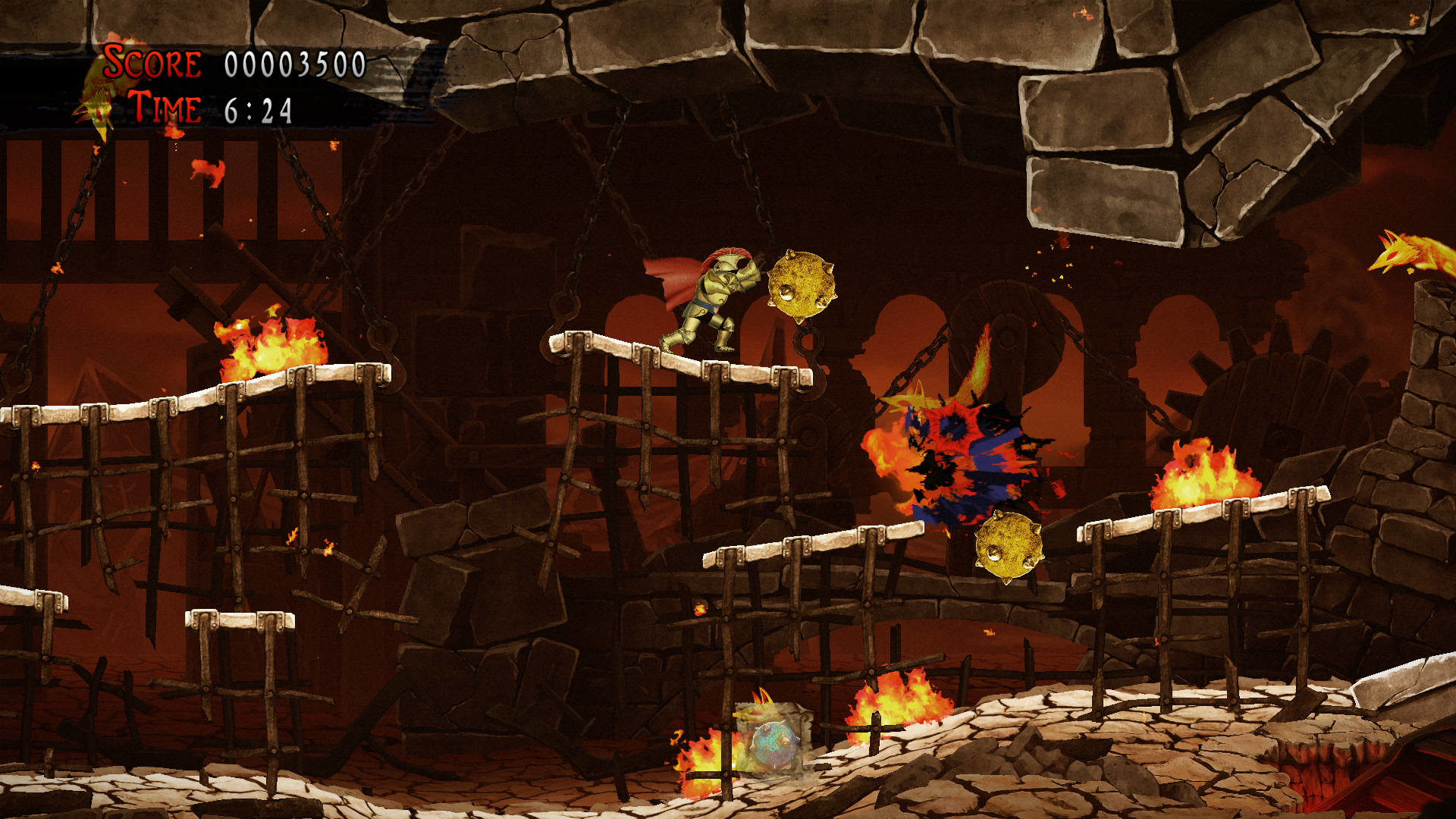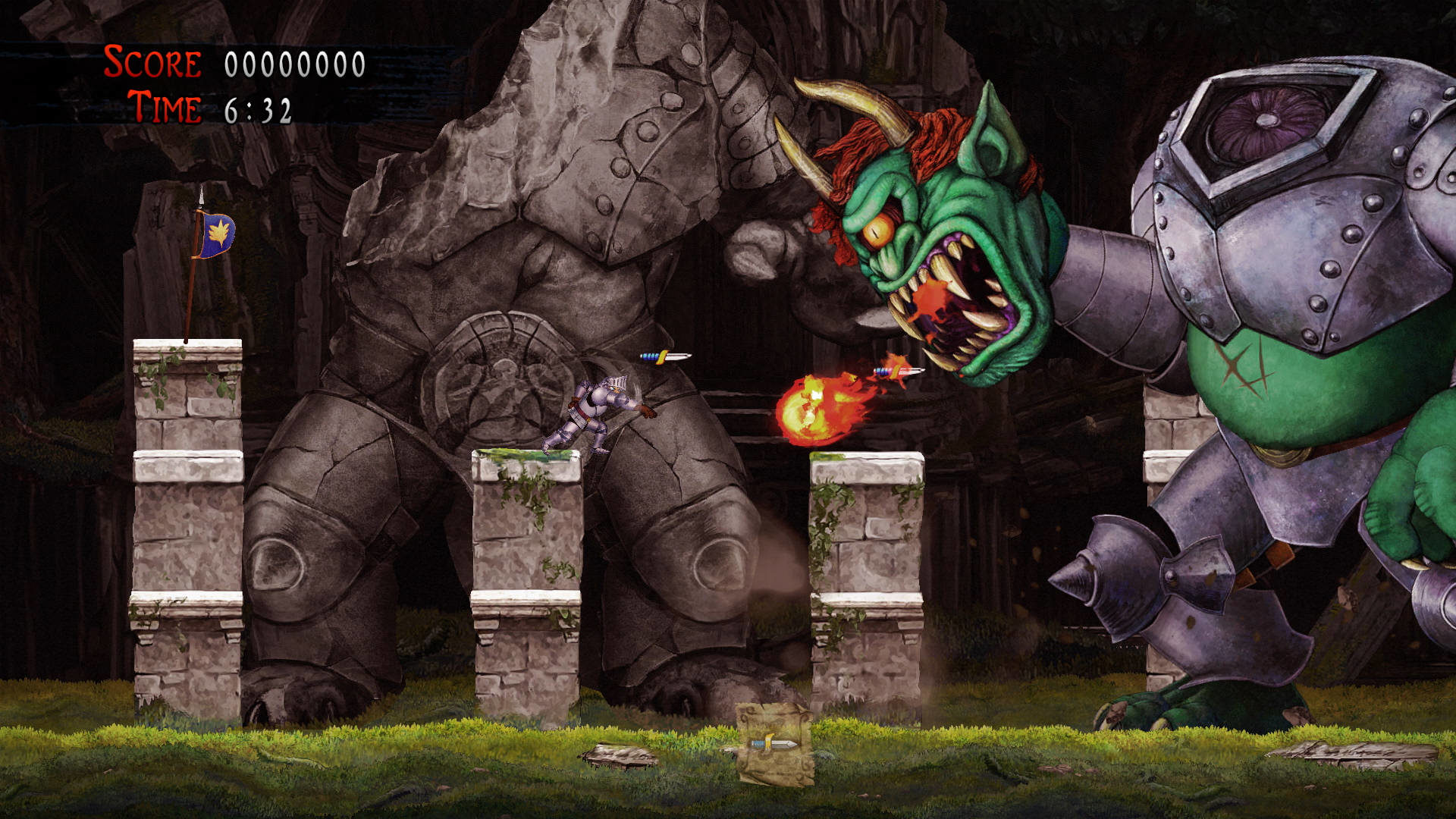Before we begin: While I’ve tried my best to not spoil some of Ghosts ‘n Goblins Resurrection’s gameplay twists, it’s impossible to review the game without discussing the biggest secret that’s been a part of all games from the franchise, and how that secret comes into play in this latest chapter.
Dark Souls is the Ghosts ‘n Goblins of 3D action RPGs.
Long before FromSoftware was inflicting its trademark brand of punishment upon willing audiences, Capcom’s side-scrolling action platformers belonged to one of the most notoriously hard franchises in gaming. With its roots in the arcade scene—where the more you die, the more you spend—the series became infamous for offering an intense level of challenge, a requirement to hone your skills, and harsh punishments should you fail. In more than a few ways, just like Dark Souls.
While it was a staple brand for Capcom during the 8- and 16-bit eras, Ghosts ‘n Goblins has had trouble finding its place in more modern years. The last proper chapter in the series was 2006’s Ultimate Ghosts ‘n Goblins on PSP, and attempts to shift those core gameplay ideas to 3D have either fizzled out or never even made it to market. When Capcom announced that it would be reviving the series with Ghosts ‘n Goblins Resurrection on the Switch, I was cautiously hopeful. The idea that we’d be getting a new, proper 2D title sounded great, but I’ve seen way too many examples of long-dormant IPs returning, only to produce games that definitely weren’t worth the wait.

Is Ghosts ‘n Goblins Resurrection the best entry the series has ever seen, or some huge new evolution that will propel the franchise back to stardom? Definitely not, and probably not. What it is, however, is a pretty darn good game, one that’s worthy of the name it sports. Having played numerous clones and homages in recent years has made me really appreciate the gameplay and stage design of Capcom’s efforts, and I do think Resurrection harks back to that classic level of craftsmanship. These types of games are nothing if the basic controls aren’t right, so thankfully protagonist Sir Arthur has a proper level of precision no matter if he’s throwing weapons, jumping, or simply trying to maneuver through the landscape. There’s a wide variety of enemies that each present their own unique threat, and every one of the game’s stages shifts its environmental hazards and layouts at a pace that (mostly) keeps you from getting bored. For those reasons, and more, the Ghosts ‘n Goblins series was one of the true pioneers in the action platformer subgenre, and Capcom hasn’t forgotten the rules it once created.
Tradition is broken somewhat in Resurrection’s Umbral Tree. By collecting Umbral Bees hidden throughout each stage, you can unlock new magic, skills, or passive abilities that will be helpful in your journey. Some of the magic has existed before via armor upgrades, such as the lighting bolts or Arthur clones from Ghouls ‘n Ghosts. Others are new to the game, like the peculiar ability to change into a boulder, or the lifesaving option for regenerating Arthur’s armor if he’s damaged down to his boxers. By far the upgrade with the biggest impact is that you can now unlock the ability to carry (and swap between) two or even three weapons. Fans of the series will know all too well the struggle of having the right weapon at the right time—and the horror of accidentally replacing the one you wanted with the one you don’t. (We’re all looking at you, Torch.)
Resurrection also includes a co-op mode, which is a nice addition, but not really my thing (at least until my children are old enough to potentially care about such games). Like with a number of other platformers with similar modes, player one controls Arthur, while player two takes charge of a helper character. In this case, that’s the ghost of an old man, who can fly around the screen to shoot projectiles, protect Arthur in a bubble shield, or even build platforms. If you’re the type who does like playing games co-op, this mode will probably be a nice addition, and can provide you with an extra bit of help getting through the challenges that await—or some amount of devilish glee if you’re player two and use those platforms to hinder instead of help.
Most surprising of all, I even came to kinda like Ghosts ‘n Goblins Resurrection’s visual style, which initially came off like the cheap “Flash animation” look that has unfortunately become popular in some circles of gaming. Capcom wanted the game to have a sort of storybook look, though I don’t think that always comes across outside of the biggest enemies and stage elements (where it’s easier to see the full detail of the art). There’s a moment in the intro when the game is being “drawn,” and the in-between style is gorgeous. I would have loved to see Capcom attempt that style instead, but maybe they did, and it just didn’t worked for the full game in practice. Still, the visuals grew on me the more I played, even if I remain a bit hesitant on the type of animation the team employed. I think Resurrection definitely could have looked better, but it could also have looked far, far worse.

In fact, against all of my expectations, the art style isn’t where we see the game’s biggest mistakes. I think the team at Capcom let some newer-era gameplay trends (that I’m not fond of) influence them, as there are times when Resurrection extends certain stage sections out way too long, trading challenge for tedium. The worst examples are some of the gimmicks that get introduced, such as riding around on dragons, or having to move through an environment restricted by deadly spikes that have closed in on all sides. Sure, we’ve seen those kinds of ideas in the series before, but it’s how they’re implemented here that’s the problem. Those two I mentioned in particular go on way too long, killing a pace that’s otherwise quick, tense, and exciting. The game’s boss fights drag on at times as well. Owing to its arcade roots, Ghosts ‘n Goblins bosses are at their best when you can quickly fell them through skill and experience. Some of Resurrection’s boss fights are pretty great—but others overstay their welcome, and become especially annoying if you don’t have the right weapon (more so than usual) or aren’t attacking your foe in the way the game wants you to.
Then there’s a major element that’s core to Ghosts ‘n Goblins Resurrection that is a positive, or a negative, or a total non-factor depending on who you are and what you’re looking for. “Resurrection” is a very apt subtitle, because the game is essentially a selection of newer elements mixed in with an array of callbacks to previous games. The first two stages are basically reimaginings of the first stages from Ghosts ‘n Goblins and Ghouls ‘n Ghosts; familiar enemies await all throughout the game, as do returning bosses; weapon and armor options are almost completely pulled from the pre-Ultimate chapters; and many of the obstacles you’ll face will be very familiar if you’re a longtime fan of the franchise.
It’s funny just how different Ghosts ‘n Goblins Resurrection is from its immediate predecessor. Resurrection leans heavily into nostalgia and keeping things “authentic,” while Ultimate Ghosts ‘n Goblins ripped the series apart down to its foundation and attempted to rebuild it into something new. While you could see what Capcom has done here as lazy or uninspired, I came away feeling differently. Nearly 30 years out from the last classic title (Super Ghouls ‘n Ghosts), Resurrection’s trip down memory lane is a welcome dose of nostalgia for a series that deserves revisiting, and which has been lost to time for a lot of players. I loved Ultimate for what it attempted to do, but I can also appreciate that this latest chapter is more about remembering the past rather than defining the future.
At this point in the review, however, I do have to make an admission: I have not beaten Ghosts ‘n Goblins Resurrection. Well, I mean, I have beaten it. Twice. It’s just that, there’s a catch this time around that I absolutely wasn’t expecting.

One of the most infamous elements to the series is that in order to see the true ending, you have to play every game through in its entirety twice, with the added requirement of also needing a certain weapon (which typically doesn’t show up until the second loop), or collecting enough of a particular item, before facing the final boss. Resurrection tweaks that by having the second playthrough unfold in “Shadow” versions of the stages. Even beyond the game’s four difficulty settings, these altered stages increase the challenge in additional ways, while also changing the visuals to a darker, moodier twist on the original landscapes.
Determined to properly beat the game before reviewing it, I set out for a second time after my first completion. In previous games, if you haven’t satisfied the requirements for facing the true final boss on the second loop, the game tells you so, and kicks you back (either to a previous stage, or back to stage selection in Ultimate) so you can get what you’re missing. I reached Resurrection’s final boss without any such notification, so I assumed I was good. After achieving victory, the game revealed that I had missed something—and instead of dropping me out to the stage selection map I’d fully unlocked, I was all of the way back at the beginning of a third loop, with only the first stage available to me.
Now look, part of this is on me. If I had paid more attention, and if I had listened to the completionist part of my brain, this might not have happened. However, at the same time, I was also feeling secure in my knowledge of 35 years of Ghosts ‘n Goblins tradition—and that tradition betrayed me. I felt upset, heartbroken, and totally defeated. Most of all, I just wasn’t up for tackling the game for a third time without some sort of break, nor was I willing to drop the difficulty so I could rush through the stages. And yet, now that I’ve had time to calm down, I’m not mad. In fact, I’m actually amused. Just as I was certain that Resurrection was more familiar than it was fresh, it did something to totally shake up that feeling of comfort. I know some people are going to hate what Capcom has done here, especially if they go into the game not knowing the catch, but I don’t.
And I will beat Ghosts ‘n Goblins Resurrection. Just as I pressed on when I so badly wanted to give up in the previous chapters of the series, I’ll do so here as well—and the fact that I’m ready to do so for a third time tells me something about the game. While my favorite classic chapter remains Ghouls ‘n Ghosts, and I still adore Ultimate for how it shook things up, Resurrection cements itself as a worthy continuation of the franchise even as it does little to push that franchise forward. If we go another 14 years without a new Ghosts ‘n Goblins, I’ll be somewhat disappointed that Capcom didn’t attempt more here. But given it didn’t have to attempt anything, and that said attempt could have gone terribly, Ghosts ‘n Goblins Resurrection is a welcome return for a series that’s still as punishingly fun as it was 30-plus years ago when it debuted.

|
★★★★☆
Ghosts ‘n Goblins Resurrection marks the return of Capcom’s brutally challenging action platformer series after a 14-year hiatus, and it’s a game that hasn’t forgotten the teachings or techniques of its ancestors. While it’s more of a “best of” for the series than a fresh new chapter, Resurrection is both a trip down memory lane, and a new experience that’ll test both longtime fans and players alike. It probably won’t resurrect the Ghosts ‘n Goblins franchise for a new era, but at least it reminds us that both Arthur and his enemies aren’t ready for the grave quite yet. |
Developer Capcom Publisher Capcom ESRB Everyone 10+ Release Date 02.25.2021 |
| Ghosts 'n Goblins Resurrection is available on Nintendo Switch. Primary version played was for Switch. Product was provided by Capcom for the benefit of this coverage. EGM reviews on a scale of one to five stars. | |

Mollie got her start in games media via the crazy world of gaming fanzines, and now works at EGM with the goal of covering all of the weird Japanese and niche releases that nobody else on staff cares about. She’s active in the gaming community on a personal level, and an outspoken voice on topics such as equality in gaming, consumer rights, and good UI. Check her out on Bluesky and Mastodon.